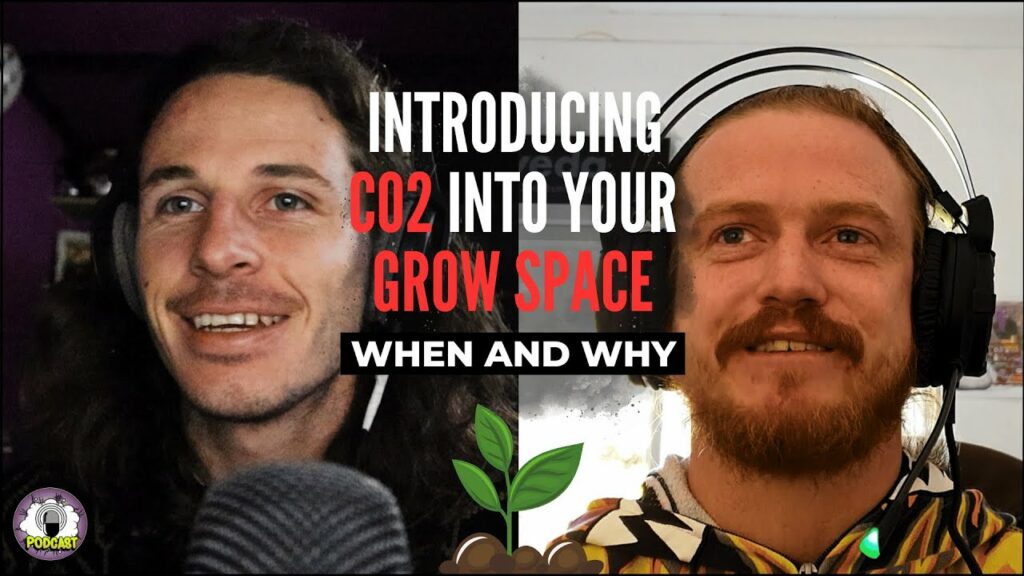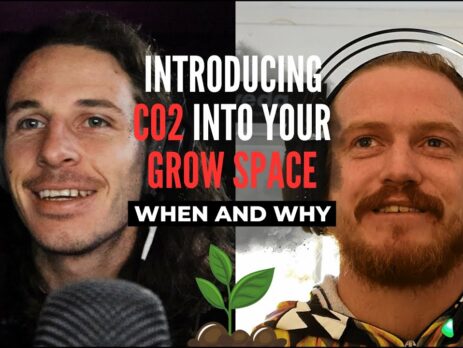Boost Plant Growth & Yields with CO2 Supplementation!
Play the audio, read along or watch the full video on YouTube
CO2 supplementation in a closed room is something we’ve started experimenting with very recently, or in the first week of flower on our first CO2 Grow. Luke and I thought it would be a good time to just open up the conversation about CO2 supplementation. Exciting topic. Hey, Luke. Yeah, no, it is, it’s a very, very exciting topic.
It’s something that we’ve been wanting to use and share. Shouldn’t have been using probably a little bit sooner, but I’m glad to be honored right now, you know, upgrading the, the room, optimizing the space, getting everything dialed in to, to what we need to do. So adding CO2 is just like the cherry on top, you know?
Yeah. I think with the climate in South Africa with relation to indoor cultivation, you know, you, it’s, you can’t have Big rooms anymore because you need to back everything up with with, with some kind of backup. So efficiency and cost saving is gonna be a big part of what we’re gonna be talking about throughout the course of 2023.
And CO2 is, in my opinion, a game changer, but it’s also, it’s quite scary. It seems more scary than it is when you don’t know anything about it. Yes. No, that is definitely true, and I think there are some essentials that you do need to. Need to know about before implementing it or, or, or even looking, looking at it, you know, I also think you need to have some experience growing without it first, a hundred percent as well, you know, because it is it is something else.
You are giving an extra supplement for further synthesis, which will probably dive into a little bit later. But, you know, there are certain things that you do have to adjust in order to, to make it work properly. So, Luke, what are you using to monitor and control this? CO2 levels in your indoor growth space.
Give me a brief breakdown of what’s happened to the ventilation systems and how you are monitoring and controlling. Okay, cool. So to monitor and control co2, obviously you, you can make use of variable. Monitoring equipment. We are making use of theros, the hydrox which has a CO2 component and attachment with it that then monitors your CO2 levels.
You obviously need to calibrate the unit before making use of it, but. Once it’s calibrated and you’ve got your added CO2 in it, monitors your levels and gives you accurate readings live readings on the app. And I can also monitor and change things remotely as well, which you know, is a big, big bonus.
So those are the type of things that you, that you use and in terms of ventilation. So while you’re implementing co2, you don’t want a fair. You know, a fresh intake and old air exit, constantly going you’re just going to be wasting and pushing CO2 out of your environment. So there, it’s, it’s better to go sort of more closed loop.
So making use of air conditioners, dehumidifiers, oscillating fans to keep your. Environmentals in check and then while adding the co2, and then obviously when the lights go off, there’s no photosynthesis, so CO2 is not needed and our device has a shutoff time that when lights are off, it doesn’t pump CO2 into the room.
And that is when I program my fans to then do the exchange. But where exactly is the CO2 coming from? It comes from a CO2 canister. So you have to buy a CO2 canister that goes with it. There’s a regulator that needs to be set up as well. And then obviously a feeding tube that the most common method, I think is attaching that feeding tube onto an oscillating fan that then blows around the ru and blows the CO2 for your, for your plants to feed off of.
Okay. Interesting. So, yeah, lots of lots of cool gear involved here, guys. But Luke, tell me a little bit about so, so just also as a, as a, as a quick note before we carry on, we saw on the, on a graph so the native CO2 is about around 300 to 400 PPM in the, in the air, and that’s what it was in the room.
And then we introduced the CO2 and it’s now sitting at 900 for the current stage, which we add and our current lighting. So very, very interesting. We’ve basically doubled it, but what exactly has this doubling done? Well? What is CO2 doing for, what is supplementing CO2 doing for the plants physically?
So CO2 is essential for photosynthesis, which is obviously the process of which. Plants convert light energy into chemical energy use to grow. So increasing the CO2 levels boosts the plant growth and can more often than not lead to yield increases at the rate of obviously photosynthesis.
And that also could essentially reduce flowering times as well. However, there is obviously. Limit to how much CO2 that you can be using that the, the plant can use itself. It’s, you know, the no use and, and could have a negative effect going beyond those limits. So taking into consideration lighting, et cetera, et cetera is essential.
Yeah. So what are some of the optimal CO2 levels in the Grow room currently for us you know, our lighting is, is putting out between, I would say, A thousand P P F D to 1,200 P P F D currently hanging at 30 centimeters. So there I would match my CO2 levels, my input CO2 levels worth my P P F D readings of, of what I’m getting across my canopy.
Okay. Excellent. And now let’s. Let’s touch on a point I think everyone’s wondering about there are obviously specific risks or certain risks involved with relation to supplementing co2. Tell me a little bit about the, the, the risks and also why having proper testing equipment is important to mitigate those, to mitigate those risks.
Yeah, look, CO2 is, is obviously dangerous to. Us as humans, so we need oxygen to breathe. And co2, you know, will completely completely deplete that and, and kill us. So obviously your environmentals and your testing equipment and what you’ve got running needs to be good. I always also think that it is good to have a backup, so, More than two monitors maybe of different devices reading.
And then also making sure that your solenoid valves and your, your, your, not your, your CO2 regulator is of a good quality as well. That is essential. Make sure that you buying a good quality regulator and that you also seal lit up properly, you know, using your seals and grommets and making sure that you tighten up nicely on all the valves that you need to, that there’s no leakages.
But you know, I think for a lot of the amount of input that us as home growers might be doing into our spaces, the CO2 might not be as high of a risk in terms of the levels. 1,200 might make you a little bit tired and, and drowsy, but you know, it’s good practice to always when you’re gonna enter into the room.
Switch your fans on, switch your co2 off, if you can close your, your regulator and just do your work, but then obviously it’s essential to make sure that you remember to switch it back on afterwards. Yeah. Not too many bangs as you forget. Yeah, exactly. Exactly. Okay. So, but yeah, they, they are risks, but just.
Be, be safe. Do your research beforehand and practice safe, safe practices. And you should be, should be good. Yeah. I think as with anything, you know, if you, if you careful, you buy the correct components and you, and you do your research, it will be, it will be successful. But all of this seems like quite a lot.
Wh why would, why would we do it? What are we going to. And li like I said at the start, you know, are we going to see those that that efficiency go up? Are we gonna save money over time and increase yields using co2? Yes, I definitely think so. You know, running the, the, the system at full capacity also you know, ourselves being fortunate enough to have taken it off grid completely.
So you know, it’s, everything is operating off, off of solar energy, so it’s all compounding at the end of the day. Our, our veg times, you know, are, are really short. Our flowering times can now be short and our yields can be bigger. So in terms of energy costs and everything, in the increase of efficiency in an indoor space, it’s it’s definitely something that I can give a two thumbs up for.
And in closing, Luke you’re going platinum Gorilla number three. It’s something you’ve worked on. We, we’ve grown many, many, many times. First time with co2. In day three or so of flower been probably a co you know maybe a week since CO2 has gone in. What are you, are you seeing a difference in growth currently?
You know, has it been noticeable or, or not? Definitely noticeable. And I’ve also noticed that, you know, I’ve gotta be a little bit heavier on my, my ec, my input ec going into the feeding system, into the medium. But, you know, keeping the v p D in check, you can, you can see almost within hours the, the growth that’s happening from it.
So it definitely has worked and it definitely is working and I’m very, very excited to see you know, the results, especially in a couple of weeks once we really start seeing those buds forming. I think we’re, I think we’re in for, for something special. As you guys can see, I don’t think we’ve ever been so amped with ran.
This run’s gonna be amazing. We’re gonna bring content, we’re gonna create a whole bunch related to what we are currently doing. We’re trying to push the, our own knowledge base so that we can educate more. Luke’s rarely been putting in the, the, the, the graft into, into learning and also designing.
So guys, if you wanna do CO2 or if you’re interested in, in pushing yourself further, definitely hit us up. And as always, remember to like and subscribe. Until next time, guys, peace.



Leave a Reply